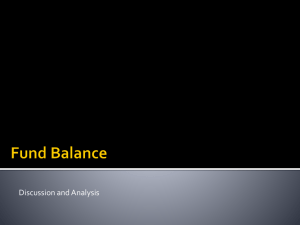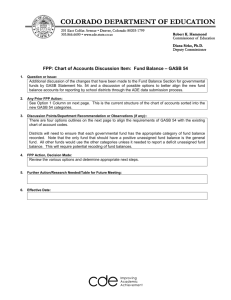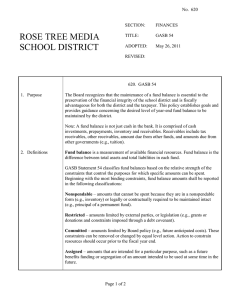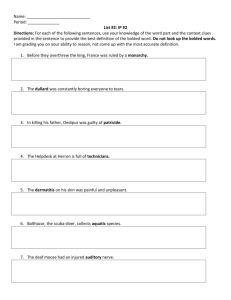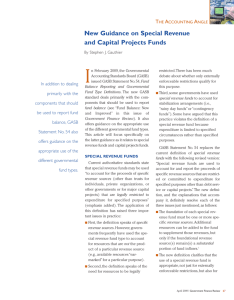– GASB 54 FPP: Sub-Committee Recommendation: Fund Balance
advertisement
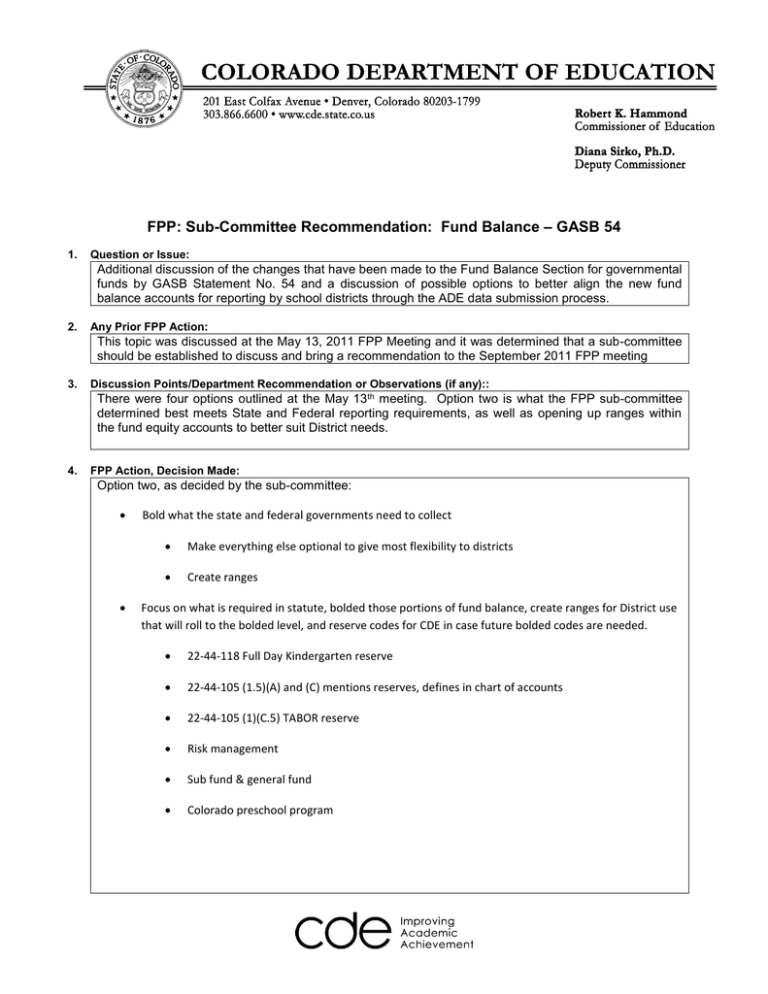
FPP: Sub-Committee Recommendation: Fund Balance – GASB 54 1. Question or Issue: Additional discussion of the changes that have been made to the Fund Balance Section for governmental funds by GASB Statement No. 54 and a discussion of possible options to better align the new fund balance accounts for reporting by school districts through the ADE data submission process. 2. Any Prior FPP Action: This topic was discussed at the May 13, 2011 FPP Meeting and it was determined that a sub-committee should be established to discuss and bring a recommendation to the September 2011 FPP meeting 3. Discussion Points/Department Recommendation or Observations (if any):: There were four options outlined at the May 13th meeting. Option two is what the FPP sub-committee determined best meets State and Federal reporting requirements, as well as opening up ranges within the fund equity accounts to better suit District needs. 4. FPP Action, Decision Made: Option two, as decided by the sub-committee: Bold what the state and federal governments need to collect Make everything else optional to give most flexibility to districts Create ranges Focus on what is required in statute, bolded those portions of fund balance, create ranges for District use that will roll to the bolded level, and reserve codes for CDE in case future bolded codes are needed. 22-44-118 Full Day Kindergarten reserve 22-44-105 (1.5)(A) and (C) mentions reserves, defines in chart of accounts 22-44-105 (1)(C.5) TABOR reserve Risk management Sub fund & general fund Colorado preschool program Option 2 is the recommendation, GASB 54 sets up 5 categories of fund balance Non-spendable 6710 bolded, range 6711-6717 will roll to 6710 Restricted (by law) 6720 bolded 6721 bolded for TABOR 3% emergency reserve 6722 bolded for TABOR multiyear obligations 6723 bolded for district emergency reserve (letter of credit or real estate) 6724 bolded for CPP 6725 bolded for full day kindergarten 6726 bolded for risk related/restricted capital 6727-6739 reserved for CDE for future use 6740-6749 district use, rolls to 6720 Committed 6750 bolded, range 6751-6757 will roll to 6750 6758-6759 reserved for CDE Assigned 6760 bolded, range 6761-6767 will roll to 6760 6718-6719 reserved for CDE 6768-6769 reserved for CDE Unassigned 6770 bolded, range 6771-6777 will roll to 6770 6778-6779 reserved for CDE Leave proprietary fund codes 6790, 6791, 6792 as is. Leave 6880 prior period adjustment as is For 2010-11 reporting use 6769 for other restricted reporting (Option 1) We’ve departed from bolding all codes in the balance sheet. We have created ranges. Moving forward the subcommittee recommends exploring creating ranges for the assets and liability categories that still meet the needs of the state and federal collections. Reserve Program codes should also be reviewed. Recommendations should be explored and approved prior to December 2011, with the intent of retroactively implementing all these changes for the FY11-12 ADE collection period. Under program code 9300/constitutional and legally mandated reserves proposes to tie the reserves to the restricted equity category per GASB 54, therefore substitute 93XX for 67XX under restricted codes above, such as 6721 equates to 9321 Program 9330 financial crisis restricted reserve no longer valid Program 9400 reserve for encumbrances no longer valid 5. Further Action/Research Needed/Table for Future Meeting: 6. Effective Date: Districts that Option 2 - Option 3 used in Option 1 - Revise all Selected FY09-10 Current Numbering Change Option 4 Selected Change Governmental Funds: Amounts that are not in a spendable form (such as inventory) Nonspendable or are required to be maintained intact (such as the corpus of an endowment fund) Reserve for Inventories Reserve for Prepaid Expenses Reserve for Encumbrances (Eliminated under GASB #54) Restricted Committed 671X 16 13 10 6751 6752 6753 Amounts constrained to specific purposes by their providers (such as grantors, bondholders, and higher levels of government), through constitutional provisions, or by enabling legislation. Reserve for TABOR 3% Reserve Reserve for TABOR Multi-year Obligations Colorado Preschool Program Reserve Risk-Related Activity Reserve Full Day Kindergarten Reserve District Emergency Reserve Other Restricted Reserve (added at Feb 2011 FPP meeting) 178 17 14 7 0 0 0 6761 6762 6765 6766 6767 6768 6769 Amounts constrained to specific purposes by a government itself, using its highest level of decision-making authority; to be reported as committed, amounts cannot be used for any other purpose unless the government takes the same highestlevel action to remove or change the constraint. Other Reserved Fund Balances Reserved fund balance 12 66 6759 6760 672X Amounts a government intends to use for a specific purpose; intent can be expressed by the governing body or by an official or body to which the governing body delegates the authority. NOTE: Most funds other than the general fund are designated for specific purposes and therefore have assigned fund balances. Designated 25 6763 Amounts that are available for any purpose; these amounts are reported only in the general fund; unless another fund must report a negative amount. Unreserved fund balance 178 6770 Invested in Capital Assets, Net of Related Debt 77 6790 Restricted Net Assets 10 6791 Unrestricted Net Assets 92 6792 Assigned Unassigned Other: Prior Period Adjustments 673X 678X (1-5) 674X 678X (6-9) 675X Proprietary Funds: 6880 Eliminate 6759, 6760, Eliminate & 6763; and 6763; and assign as assign as needed in needed in future future 678X Fact Sheet about Fund Balance Reporting and Governmental Fund Type Definitions 1. Why has the GASB issued new standards for reporting fund balance? The GASB issued Statement No. 54, Fund Balance Reporting and Governmental Fund Type Definitions, to address issues related to how fund balance was being reported. The GASB’s original intention was to clear up confusion regarding the relationship between reserved fund balance and restricted net assets. However, the GASB’s research revealed that the existing standards guiding fund balance reporting were being interpreted inconsistently by different governments. Consequently, the fund balance information reported by many governments also was inconsistent. It also became clear that the understandability of fund balance information was affected and that financial statement users were unable to readily interpret reported fund balance information. 2. Why did the GASB decide not to just clarify the existing fund balance classifications (reserved, designated, unreserved)? The GASB considered pursuing a solely educational approach to these issues. However, it became apparent based on interviews and survey results that, even if all governments interpreted the requirements consistently, the resulting information would not meet the needs of people who use fund balance information to identify available resources and assess liquidity and financial flexibility. 3. How will governments report fund balance in the future? Fund balance will be displayed in the following classifications depicting the relative strength of the spending constraints placed on the purposes for which resources can be used: Nonspendable fund balance—amounts that are not in a spendable form (such as inventory) or are required to be maintained intact (such as the corpus of an endowment fund) Restricted fund balance—amounts constrained to specific purposes by their providers (such as grantors, bondholders, and higher levels of government), through constitutional provisions, or by enabling legislation Committed fund balance—amounts constrained to specific purposes by a government itself, using its highest level of decision-making authority; to be reported as committed, amounts cannot be used for any other purpose unless the government takes the same highest-level action to remove or change the constraint Assigned fund balance—amounts a government intends to use for a specific purpose; intent can be expressed by the governing body or by an official or body to which the governing body delegates the authority Unassigned fund balance—amounts that are available for any purpose; these amounts are reported only in the general fund. 4. Why is unassigned fund balance reported only in the general fund? When a government transfers resources from the general fund to another governmental fund, it is communicating that, at a minimum, it intends to use those resources for the purpose of the fund receiving them. This expression of intent meets the requirements for classification as assigned fund balance. Because unassigned fund balance represents amounts that are not constrained in any way, not even by an intention to use them for a specific purpose, the general fund is the only appropriate place to report this classification of fund balance. In the other governmental funds, however, if a government spends more on a specific purpose than the resources available for that purpose in the fund, then it may need to report a negative amount as unassigned fund balance. If a government cannot cover the deficit with amounts assigned to other purposes in that fund, then the remaining deficit should be reported on the unassigned fund balance line. 5. How will rainy-day amounts be reported under Statement 54? Statement 54 treats stabilization arrangements as a specific purpose, allowing governments to report these amounts in the general fund as restricted or committed, if they meet the applicable definitions and criteria. Stabilization amounts that do not qualify to be reported as restricted or committed should be included in unassigned fund balance. Governments may report stabilization amounts in a special revenue fund only if they derive from specific revenue sources that are restricted or committed to stabilization. Regardless of where stabilization amounts are reported, governments also will disclose key information about their stabilization arrangements in the notes to the financial statements, including the authority by which the arrangements were established, the conditions under which additions to the stabilization amounts are required, and the circumstances under which amounts may be used. 6. How has Statement 54 changed the way encumbrances are reported? The new standards clarify that an encumbrance is not a specific purpose and therefore should not be reported as a separate line on the face of the balance sheet. Encumbering amounts that are restricted or committed does not further limit the purposes for which they can be used. If the encumbering process meets the definition and criteria for committed fund balance, then encumbering an assigned or unassigned amount could result in the amount being reported as committed; however, it would be reported with other amounts committed to the same or similar purposes, not as “committed for encumbrances.” If a government has significant encumbrances, it should disclose them under the standards for significant commitments. 7. What did the GASB find out about the reporting of governmental funds? In practice, many governments have interpreted in different ways the prior standards on reporting governmental funds contained in National Council on Governmental Accounting (NCGA) Statement 1, Governmental Accounting and Financial Reporting Principles. This is particularly true for special revenue funds. 8. How does Statement 54 clarify the special revenue fund type definition? Statement 54 makes clear that, for financial reporting purposes, a special revenue fund may only be established around one or more revenue sources that are restricted or committed to purposes other than capital projects or debt service. For example, a school district might report state and federal aid for elementary and secondary education in a special fund if those revenue sources represent a substantial portion of the fund’s total inflows. 9. How does Statement 54 clarify the definitions of debt service and capital projects fund types? Statement 54 revises the definitions of the debt service and capital projects fund types so that consistent language and structure are used across all of the governmental fund type definitions. Although the existing definition of a capital project fund specifies that they should be used to account for “the acquisition or construction of major capital facilities,” many governments have used them to report on capital assets that are not facilities or major or either. Based on constituent feedback, the GASB broadened the definition to encompass capital outlays in general. 10. How will Statement 54 impact the reporting of governmental funds? The most significant changes are likely to occur in the reporting of special revenue funds, because that is where there has been the most variation in how the prior standards were interpreted. Some governments may not be able to continue to report some of their special revenue funds under the clarified definition. The Statement 54 definition is considered by some to be more permissive that the NCGA Statement 1 definition. However, practice has varied so much that the Statement 54 definition may appear more restrictive to some governments. 11. Does Statement 54 affect how governments use funds for internal accounting purposes or for special reporting? No. Statement 54 affects only the reporting of governmental funds in general purpose external financial reports in conformity with generally accepted accounting principles (GAAP). Governments may continue to use any funds they choose or are required to for their internal accounting or for special purpose reporting. 12. What if a state law requires local governments to report a particular type of fund or to report using the current classifications of fund balance? For general purpose external financial reporting under GAAP, governments are required to follow Statement 54. If a law conflicts with Statement 54 or any other part of GAAP, the legal requirements can be met by presenting supplemental schedules. Governments will still be able to comply with such state laws in their general purpose external financial report, but outside of the basic financial statements, notes to the basic financial statements, and required supplementary information. 13. What other note disclosures does Statement 54 require? In addition to the disclosures already mentioned, Statement 54 requires governments to disclose: Additional detail regarding the purposes of restrictions, commitments, and assignments, if the required level of detail is not met through display on the face of the balance sheet The decision-making authority and formal action, if any, that results in commitments of fund balance The bodies or persons with the authority to express intended uses of resources that result in assigned fund balance The order in which a government assumes restricted, committed, assigned, and unassigned amounts are spent when amounts in more than one classification are available for a particular purpose Information about minimum fund balance policies, if a government has one The purpose for each major special revenue fund, identifying which revenues and other resources are reported in each of those funds. 14. When should Statement 54 be implemented? Governments should implement Statement 54 no later than the first fiscal year beginning after June 15, 2010 (for example, the fiscal year starting on July 1, 2010 and ending on June 30, 2011). Governments are encouraged to implement the standards earlier.
